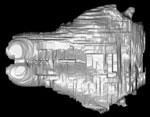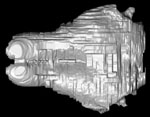Abstract from Rowe, T., Macrini, T.E., and Luo, Z.-X. 2011. Fossil evidence on origin of the mammalian brain (Science, 332, 955-957):
Many hypotheses have been postulated regarding the early evolution of the mammalian brain.
Here, X-ray tomography of the Early Jurassic mammaliaforms Morganucodon and Hadrocodium
sheds light on this history. We found that relative brain size expanded to mammalian levels, with
enlarged olfactory bulbs, neocortex, pyriform cortex, and cerebellum, in two evolutionary pulses.
The initial pulse was probably driven by increased resolution in olfaction and improvements in
tactile sensitivity (from body hair) and neuromuscular coordination. A second pulse of olfactory
enhancement then enlarged the brain to mammalian levels. The origin of crown Mammalia saw a third
pulse of olfactory enhancement, with ossified ethmoid turbinals supporting an expansive olfactory
epithelium in the nasal cavity, allowing full expression of a huge odorant receptor genome.
*Click the Additional Imagery tab for endocast animations.

Literature
Alroy, J. 1998. Cope's Rule and the dynamics of body mass evolution in North American fossil mammals. Science 280:731-734.
Bloch, J. I., Rose, K. D. and P. D. Gingerich. 1998. New species of Batodonoides (Lipotyphla, Geolabididae) from the early Eocene of Wyoming: Smallest known mammal? Journal of Mammalogy 79:804-827.
Cifelli, R. L., Wible, J. R. and F. A. Jenkins. 1998. Triconodont mammals from the Cloverly Formation (Lower Cretaceous), Montana. Journal of Vertebrate Paleontology 18:237-241.
Clemens, W. A. 1980. Rhaeto-Liassic mammals from Switzerland and West Germany. Zitteliana 5:51–92.
Foote, M. 1997. The evolution of morphological diversity. Annual Review of Ecology and Systematics 28:129-152.
Fraser, N. C., Walkden, G. M., and V. Stewart. 1985. The first pre-Rhaetic therian mammal. Nature 314:161-163.
Herring, S. W. 1993. Formation of the vertebrate face: epigenetic and functional influences. American Zoologist 33:472-483.
Hu, Y.-M., Wang, Y.-Q., Luo, Z.-X., and C.-K. Li. 1997. A new symmetrodont mammal from China and its implications for mammalian evolution. Nature 390:137-142.
Jenkins, F. A., Crompton, A. W. and W. R. Downs. 1983. Mesozoic mammals from Arizona -- new evidence on mammalian evolution. Science 222:1233-1235.
Ji, Q., Luo, Z.-X. and S.-A. Ji. 1999. A Chinese triconodont mammal and mosaic evolution of the mammalian skeleton. Nature 398:326-330.
Kielan-Jaworowska, Z. 1996. Characters of multituberculates neglected in phylogenetic analyses of early mammals. Lethaia 29:249-266.
Kielan-Jaworowska, Z. and J. H. Hurum. 1997. Djadochtatheria: a new suborder of multituberculate mammals. Acta Palaeontologica Polonica 42:201-242.
Luo, Z.-X., Crompton, A. W. and S. G. Lucas. 1995. Evolutionary origins of the mammalian promontorium and cochlea. Journal of Vertebrate Paleontology 15:113-121.
Luo, Z.-X., Crompton, A. W. and A.-L. Sun. 2001. A new mammaliaform from the Early Jurassic and evolution of mammalian characteristics. Science 292:1535-1540.
Musser, A. M. and M. Archer. 1998. New information about the skull and dentary of the Miocene platypus Obdurodon dicksoni, and a discussion of ornithorhynchid relationships. Philosophical Transactions of the Royal Society Series B 353:1063-1079.
Parrington, F. R. 1978. Further account of Triassic mammals. Philosophical Transactions of the Royal Society of London Series B 282:177-204.
Rowe, T. B. 1988. Definition, diagnosis, and origin of Mammalia. Journal of Vertebrate Paleontology 8:241-264.
Rowe, T. B. 1996. Coevolution of the mammalian middle ear and neocortex. Science 273:651-654.
Sidor, C. A. and J. A. Hopson. 1998. Ghost lineages and "mammalness": assessing the temporal pattern of character acquisition in the Synapsida. Paleobiology 24:254-273.
Sigogneau-Russell, D., and R. Hahn. 1995. Reassessment of the late Triassic symmetrodont mammal Woutersia. Acta Palaeontologica Polonica 40:245–260.
Smith, K. K. 1997. Comparative patterns of craniofacial development in eutherian and metatherian mammals. Evolution 51:1663-1678.
Van Valkenburgh, B. 1995. Tracking ecology over geological time: evolution within guilds of vertebrates. Trends in Ecology and Evolution 10:71-76.
von Maier, W. 1989. Morphological studies on the auditory bulla of marsupials. Zeitschrift fur Zoologische Systematik und Evolutionsforschung 27:149-168.




 ,
, 






